Hunting the rave with the help of virtual reality
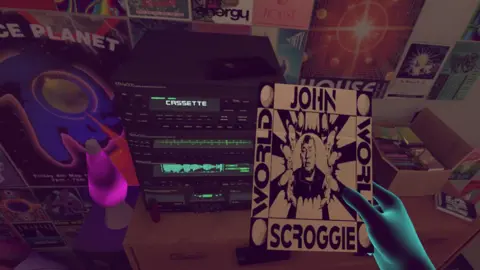 In Pursuit of Repetitive Beats
In Pursuit of Repetitive BeatsIn 1989, the Acid House rave scene was very much a covert, and often illegal, affair.
Before social media and mobile phones, picking up the scent for a secret warehouse event was tricky - but the dedicated ravers always got to the party.
Now though, with the help of interactive, virtual reality (VR), you can re-live the trip back to that era, or immerse yourself in it for the first time.
It is all down to Darren Emerson - creator of exhibition In Pursuit of Repetitive Beats - who says capturing the element of adventure was crucial.
The exhibition has begun a tour across the UK, with Birmingham its first port of call.
It takes visitors on a full rave journey - first, trying to find out where the party is while avoiding the police and then immersing yourself in the music.
A VR headset guides you through various stages - the car journey, even a police station, while a vibrating haptic vest helps you feel the bass in the warehouse, before you emerge into the morning sun after a night of dancing.
"This is also a lived experience for me," says Mr Emerson, namesake of the global DJ and ex-Underworld member.
"I wasn't around in 1989, but I did do this stuff in the mid-90s and you'll see that there's a red Peugeot in it - my mate used to have a red Peugeot and we'd travel round the country trying to find these raves and having this amazing time and I really wanted to represent the adventure element."
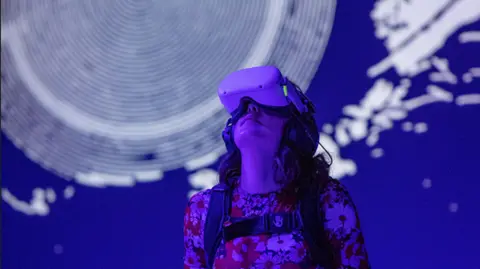 Mark McNulty
Mark McNultyHe said it was really important to base the exhibition around 1989, being the year old ravers tend to remember most.
"The fact they didn't know where they were going, they were out on a limb, they didn't have mobile phones, or GPS and it really was a cat and mouse game to try to get to this party," he says.
"So, I thought that was a good premise for a VR experience but also a documentary experience - it's very much a documentary but it's a documentary that you're in."
He had considered basing it around the M25 area, but knew the same scene was bursting into life in the West Midlands.
Working with Coventry City of Culture Trust in 2021-2 to first create the experience, organisers decided the region deserved a share of the nostalgic limelight.
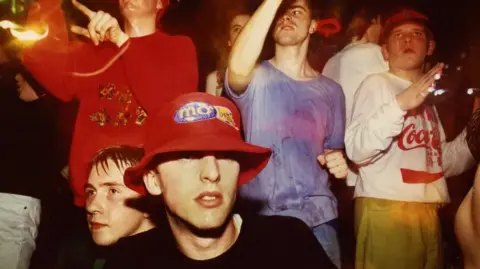 Tony Davis / British Culture Archive
Tony Davis / British Culture Archive "Coventry, the West Midlands - and we do focus on this in our exhibition - the Birmingham scene, really was at the forefront of this change and it's not often cited," he said.
"You will hear about Manchester and the Hacienda until the cows come home and London and the M25 and Sunrise and those Orbital raves and Blackburn getting attention and that's not to take away from any of those scenes.
"But, Coventry and Birmingham and the West Midlands as a whole needs to be in that conversation as well."
The Eclipse nightclub in Coventry was the first venue to have an all-night licence which pulled in ravers from around the country and the Amnesia House brand was also growing in the city and becoming a pioneer in "putting on all-nighters".
"These aren't local things, they are beacons that would attract people that were into this at the time," he added.
 Darren Emerson
Darren Emerson"You could very easily have a group of people leaving London and going up the M6 in search of this Amnesia House rave so for me, it had that sort of universal sense," he says.
"It's really about that spirit of adventure, it's about being young and going on those seminal nights that really define who you are as you move from being a teenager, I guess, living in your parent's house to being an adult and who are the people who are going to shape who you're going to become and these are the nights that do that.
"So at the end of it when you come out into the sunrise, it's like a new dawn - that feeling of like 'I've just done something incredible and now I feel changed."
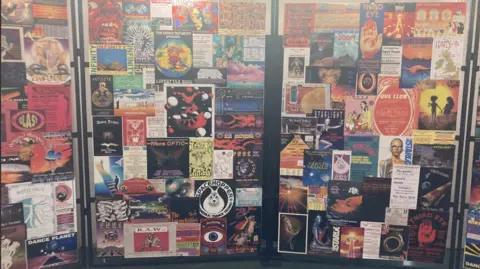
Choosing 1989 was also pertinent - the scene was in its infancy and innocent - while societal changes and political volatility was sweeping through the UK.
It was the end of Thatcherism, there was high unemployment, industry had closed down somewhat - with car-making reduced in Coventry - and abandoned warehouses were being put to use by partygoers.
"People were reclaiming this, it's about people doing something for themselves and it feels to me like one of the last real youth revolutions in that sense culturally that changed everything," Mr Emerson says.
"Dance music is now ubiquitous, it's commercial, it's everywhere but it starts from this."
However, nowadays bigger clubs are closing down and society and the night-time economy has changed again, he said.
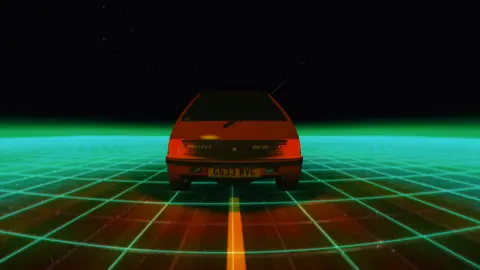 In Pursuit of Repetitive Beats
In Pursuit of Repetitive BeatsBut the experience has a lot to offer to people who weren't there at the time - it's not just for nostalgic ravers.
"We've had so many people coming out crying with joy and wanting to hug," he added.
"As a team, and we're not there all the time, but we've given out so many hugs to people who are like, 'Oh man, I just need a hug' because they feel so emotionally connected to it," says Mr Emerson.
"So there's a lot of nostalgia, there's a lot of things for people to learn who weren't there and we've had families who have brought their teenage kids and going, 'Look this is how we used to do it'."
The award-winning project (produced by East City Films) will visit eight cities across the UK with Waterhall at Birmingham Museum & Art Gallery, where it is now open until 1 September.
Sara Wajid, joint CEO of Birmingham Museums Trust, said: "I knew after trying the experience and the amount of joy I felt that we had to be a part of bringing this experience to the people of Birmingham and the West Midlands.
“Bringing joy, music and history together in The Waterhall marks the next exciting step in re-opening Birmingham Museum & Art Gallery – the first spaces of which will open later this year."
 Tony Davis / British Culture Archive
Tony Davis / British Culture Archive Follow BBC West Midlands on Facebook, X and Instagram. Send your story ideas to: [email protected]
